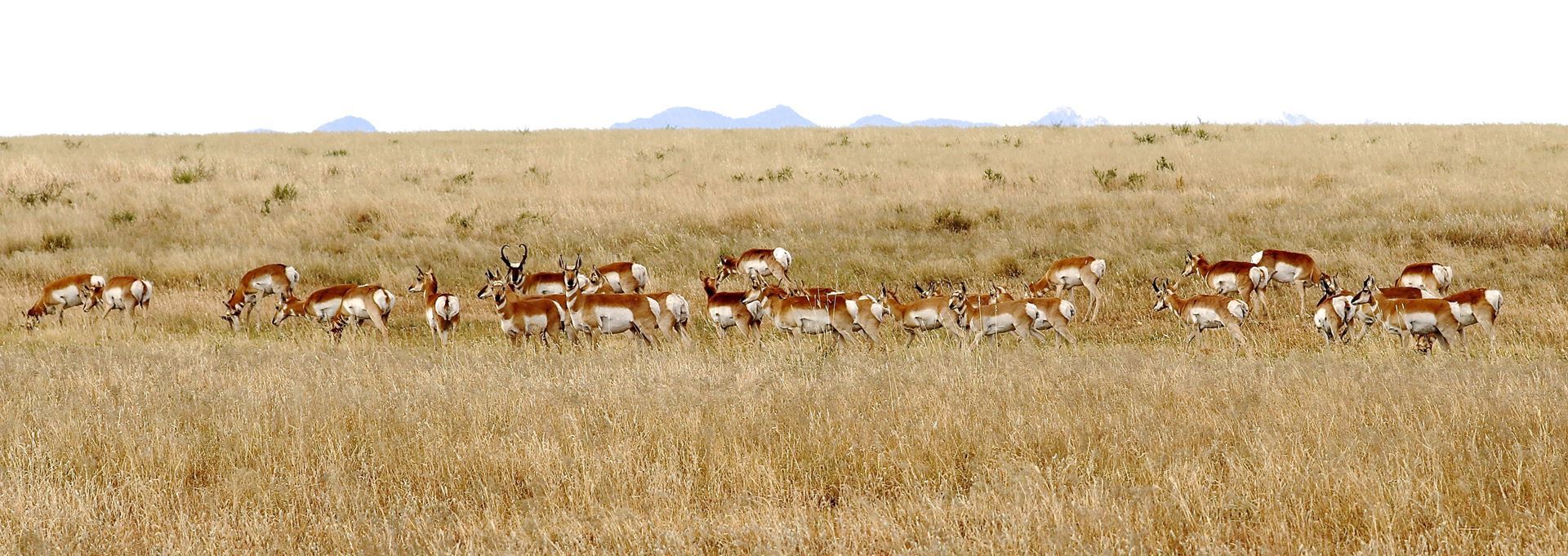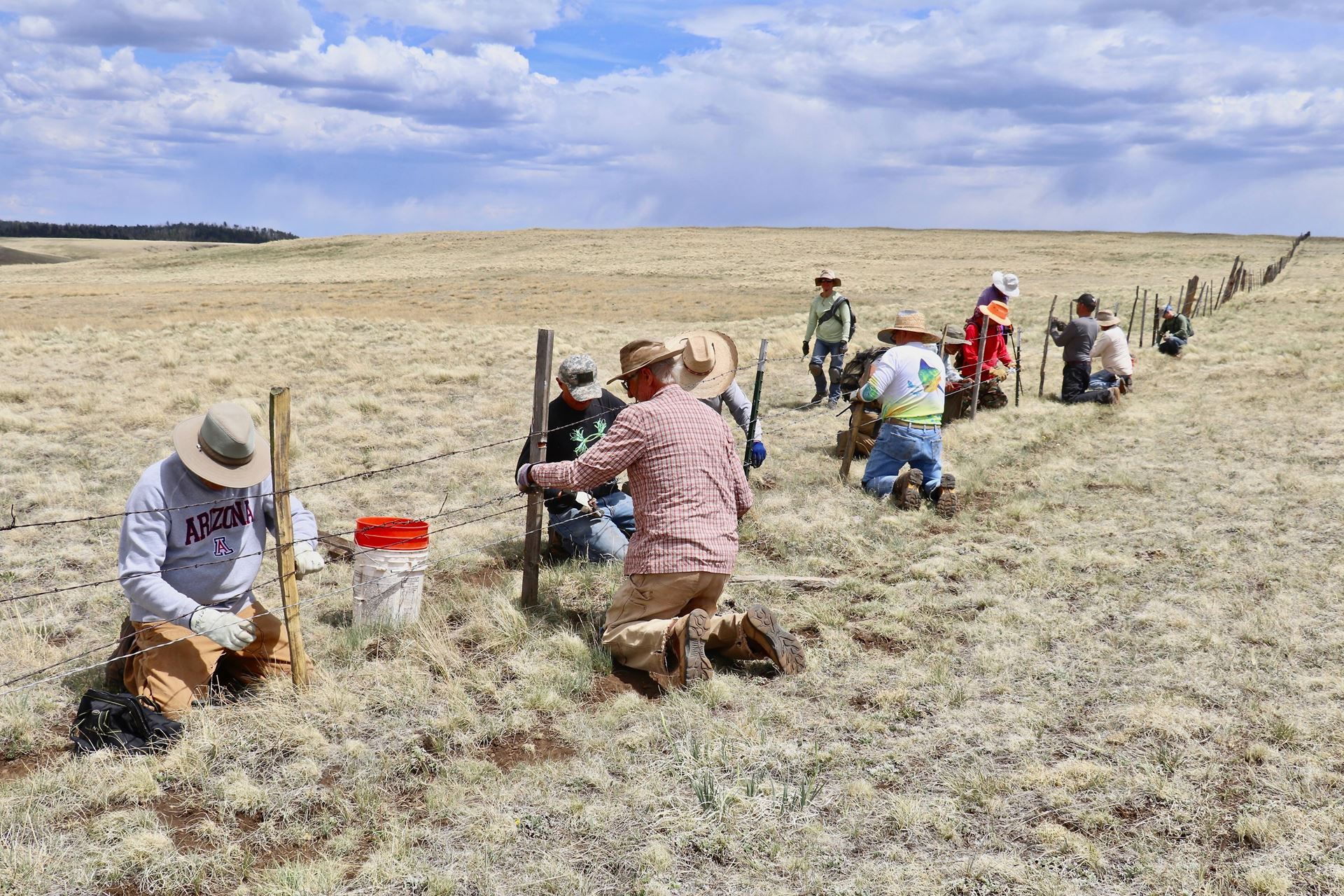
Author: Elise Lange, AWF Communications Manager, Trica Oshant-Hawkins, AWF Conservation Programs Director, and Glen Dickens, AWF Board President
Our Centennial Spotlight for January is the pronghorn antelope, a species that went from under 1,000 individuals in 1922 to around 10,000 today — just about 100 years later. You can read about the amazing journey this species went through in our blog below, and in the associated article at this link.
Pronghorns — they’re a favorite animal for visitors to the southwest to see, but they also have a special place in the hearts of Arizona conservationists and outdoor enthusiasts. While they are often called antelopes, they are actually in a family of their own. They are also an incredibly important part of Arizona’s ecosystems.
Weighing up to 100 pounds and measuring three to five feet in length, this species is named for their pronged-horns — a shocking revelation, indeed! All jokes aside, they are one of the few mammals that have true horns. True horns are made of bone covered by specialized hair follicles that make a substance similar to keratin, which is what human hair and nails are made of. The only species that are known to have true horns besides pronghorn are cows, sheep, goats, true antelopes, and other related species.
The pronghorn antelope is the last surviving member of its family, the Antilocapridae. Its closest relatives aren’t even in North America — they’re the giraffes and okapis of Africa! Long before European colonization, pronghorns numbered in the millions and ranged west across open plains from the central U.S. to eastern California, north into southern Canada and south into northern Mexico.
Unfortunately, pronghorns very nearly died out from unregulated hunting and habitat loss during the latter part of the nineteenth century. This was, of course, long before we had the Arizona Game and Fish Department that now helps manage our wildlife species.
For those familiar with pronghorn, it may seem hard to imagine that we could have hunted these amazing animals to near-extinction. Afterall, they are well-known for their enormous eyes giving them a 320-degree field of vision. How can you hunt something that’s able to see in an almost complete circle? They’re also incredibly fast. A pronghorn can run more than 60 miles per hour in short bursts. That’s about the speed that you’re supposed to go on most of Arizona backcountry highways. Pronghorn are often cited as the world's second-fastest land animal right behind…can you guess?
The cheetah!
Nonetheless, the Arizona pronghorn population dwindled to less than 1,000 individuals by 1922, one year before the creation of the AWF. It was at this point that the new field of wildlife management began to take hold in Arizona and across the country. Through scientific management of the species, including attention to habitat, hunting seasons, and “bag limits,” pronghorn populations began to increase. With additional help from predator control programs, closed seasons, citizen involvement, and especially from translocations (relocating animals to areas where population numbers need a boost), pronghorn populations today are around 10,000 individuals.
There has now been over 100 years of conservation attention to this species, and in many places, their populations are thriving! While hunting regulations and scientific management have clearly helped pronghorn, one of the biggest concerns of today is the impact of increasing human development.
More roads, homes, apartment complexes, and other structures being built means less habitat for wildlife. Additionally, pronghorn are not particularly good at jumping, which is a big issue in rural areas that have large expanses of fenced land. Fences impede wildlife movement and entangle animals. They can also separate entire populations from one another, or separate young from their mothers. Roads are also a major wildlife barrier, with deadly consequences to both animals and drivers.
Fortunately, in Arizona (and other states in the west) various organizations and agencies are working together on projects to provide safe corridors for wildlife travel by removing unnecessary fencing and building road crossings. This not only helps to reconnect separated populations, but it prevents species from injuring themselves on fences or being killed on roads.

The Arizona Antelope Foundation, an affiliate of AWF, has worked extensively for many years successfully addressing these issues and restoring pronghorn antelope populations in Arizona. You can read more about their amazing work and the history of pronghorn in Arizona here. AWF has also worked to remove barbed wire in areas across the state. Recently, AWF, along with a coalition of other organizations and agencies, formed “Desert Fence Busters,” with the primary mission of removing old, abandoned barbed wire fencing from public lands in southern Arizona.
As you can see, wildlife conservation is a group effort. Thanks to the work of conservationists (including you!), this critical species has made leaps and bounds — despite their inability to jump well! While there is always more work to do, the pronghorn antelope’s future is bright in Arizona. So next time you are out on the range, keep an eye out for this majestic animal.
.png)